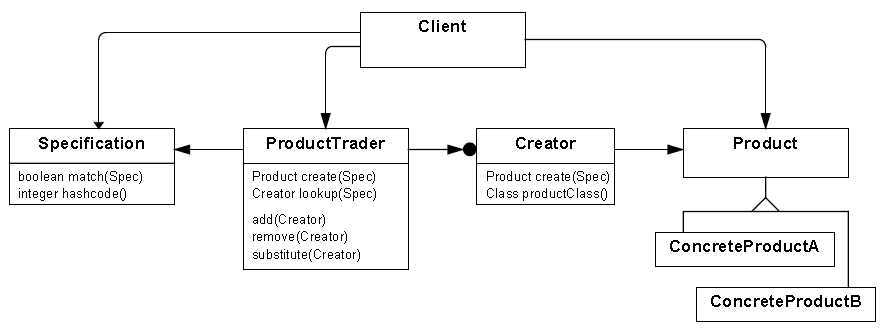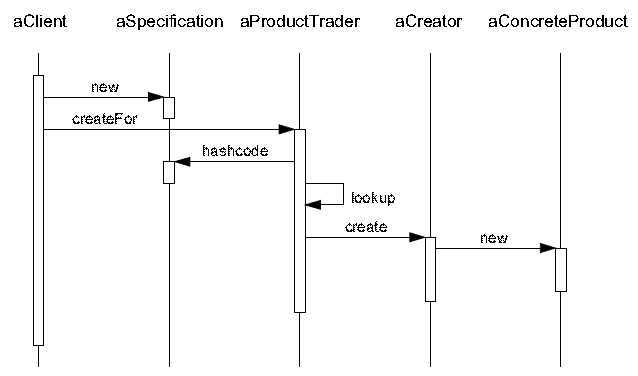标签:des style blog class c code
索引
使客户程序可以通过命名抽象超类和给定规约来创建对象。
Product Trader 让客户程序与 Product 类解耦,从而使得类的层级结构、框架和应用程序易于改写、配置和演进。
Let clients create objects by naming an abstract superclass and by providing a specification.
A Product Trader decouples the client from the product and thereby eases the adaption, configuration and evolution of class hierarchies, frameworks and applications.

Client
Product
ConcreteProduct
ProductTrader
Creator
Specification

当以下情况成立时可以使用 Product Trader 模式:
1 namespace ProductTraderPattern.Implementation1 2 { 3 public class Specification 4 { 5 public string Criteria { get; set; } 6 7 public bool IsSatisfiedBy(Product product) 8 { 9 return product.Criteria == this.Criteria; 10 } 11 12 public override int GetHashCode() 13 { 14 return Criteria.GetHashCode(); 15 } 16 17 public override bool Equals(object obj) 18 { 19 return GetHashCode().Equals(obj.GetHashCode()); 20 } 21 } 22 23 public abstract class Product 24 { 25 public abstract string Criteria { get; } 26 } 27 28 public class ConcreteProductA : Product 29 { 30 public override string Criteria 31 { 32 get 33 { 34 return "SpecForConreteProductA"; 35 } 36 } 37 } 38 39 public class ConcreteProductB : Product 40 { 41 public override string Criteria 42 { 43 get 44 { 45 return "SpecForConreteProductB"; 46 } 47 } 48 } 49 50 public abstract class ProductCreator 51 { 52 public abstract Product Create(Specification spec); 53 } 54 55 public class ConcreteProductCreator : ProductCreator 56 { 57 public override Product Create(Specification spec) 58 { 59 if (spec.Criteria == "SpecForConreteProductA") 60 { 61 return new ConcreteProductA(); 62 } 63 else if (spec.Criteria == "SpecForConreteProductB") 64 { 65 return new ConcreteProductB(); 66 } 67 68 // any factory you can use here 69 throw new NotSupportedException(); 70 } 71 } 72 73 public class ProductTrader 74 { 75 private Dictionary<Specification, ProductCreator> _dict 76 = new Dictionary<Specification, ProductCreator>(); 77 78 public Product CreateFor(Specification spec) 79 { 80 ProductCreator creator = LookupCreator(spec); 81 Product product = creator.Create(spec); 82 return product; 83 } 84 85 public ProductCreator LookupCreator(Specification spec) 86 { 87 return _dict[spec]; 88 } 89 90 public void AddCreator(Specification spec, ProductCreator creator) 91 { 92 _dict.Add(spec, creator); 93 } 94 95 public void RemoveCreator(Specification spec, ProductCreator creator) 96 { 97 _dict.Remove(spec); 98 } 99 100 public void SubstituteCreator(Specification spec, ProductCreator creator) 101 { 102 _dict[spec] = creator; 103 } 104 } 105 106 public class Client 107 { 108 public void TestCase1() 109 { 110 Specification spec1 = new Specification(); 111 spec1.Criteria = "SpecForConreteProductA"; 112 113 Specification spec2 = new Specification(); 114 spec2.Criteria = "SpecForConreteProductA"; 115 116 ProductCreator creator = new ConcreteProductCreator(); 117 118 ProductTrader trader = new ProductTrader(); 119 trader.AddCreator(spec1, creator); 120 trader.AddCreator(spec2, creator); 121 122 Specification spec3 = new Specification(); 123 spec3.Criteria = "SpecForConreteProductA"; 124 125 Product product = trader.CreateFor(spec3); 126 } 127 } 128 }
《设计模式之美》为 Dennis Gao 发布于博客园的系列文章,任何未经作者本人同意的人为或爬虫转载均为耍流氓。
设计模式之美:Product Trader(操盘手),布布扣,bubuko.com
标签:des style blog class c code
原文地址:http://www.cnblogs.com/gaochundong/p/design_pattern_product_trader.html